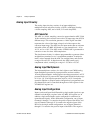
Chapter 3 Theory of Operation
©
National Instruments Corporation 3-7 AT-MIO-16X User Manual
input of the PGIA in single-ended mode is connected to either the input
ground or the AI SENSE signal at the I/O connector depending on the
nature of the input signals.
PGIA
The PGIA fulfills two purposes on the AT-MIO-16X board. It converts
a differential input signal into a single-ended signal with respect to the
AT-MIO-16X ground for input common-mode signal rejection. This
conversion allows the input analog signal to be extracted from any
common-mode voltage or noise before being sampled and converted.
The PGIA also applies gain to the input signal, amplifying an input
analog signal before sampling and conversion to increase measurement
resolution and accuracy. Software-selectable gains of 1, 2, 5, 10, 20, 50,
and 100 are available through the AT-MIO-16X PGIA on a per channel
basis.
ADC FIFO Buffer
When an A/D conversion is complete, the ADC circuitry shifts the
result into the ADC FIFO buffer. The FIFO buffer is 16-bits wide and
512-words deep. This FIFO serves as a buffer to the ADC and is
beneficial for two reasons. Any time an A/D conversion is complete, the
value is saved in the FIFO buffer for later reading, and the ADC is free
to start a new conversion. Secondly, the FIFO can collect up to 512 A/D
conversion values before any information is lost; thus software or DMA
has extra time (512 times the sample interval) to catch up with the
hardware. If more than 512 values are stored in the FIFO without the
FIFO being read from, an error condition called FIFO overflow occurs
and A/D conversion information is lost. When the ADC FIFO contains
a single A/D conversion value or more, it can generate a DMA or
interrupt request to be serviced.
Analog Input Calibration
Measurement reliability is assured through the use of the onboard
calibration circuitry of the AT-MIO-16X. This circuitry uses a stable,
internal, +5 VDC reference that is measured at the factory against a
higher accuracy reference; then its value is permanently stored in the
EEPROM on the AT-MIO-16X. With this stored reference value, the
AT-MIO-16X board can be recalibrated without additional external
hardware at any time under any number of different operating
conditions in order to remove errors caused by temperature drift and
time. The AT-MIO-16X is calibrated at the factory in both unipolar and


















